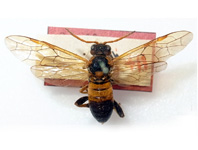Abstract
A new oogenus and oospecies of the Elongatoolithidae, Undulatoolithus pengi oogen. et oosp. nov., is described on the basis of specimens from the Upper Cretaceous Zhoutian Formation of the Pingxiang Basin, Jiangxi Province, China. The eggs are slightly asymmetrical, paired, and lay radially-oriented in a circular configuration within the clutch, and most suggestive of Macroolithus of the Elongatoolithidae by medium-sized eggs with average polar axis and equatorial diameter of 19.36 and 8.35 cm, and the ornamentation pattern of nodes and ridges on the outer surface. The new oogenus differs from Macroolithus in its prominent ridges 0.67 mm in height, about half of the entire eggshell thickness, gradational boundary between the cone layer and the overlying columnar layer, cone layer-to-columnar layer thickness ratio of 1/8 or 1/4. This discovery adds new data on the morphology and diversification of Late Cretaceous elongatoolithid ootaxa.

